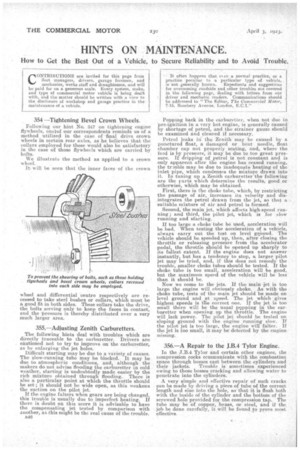HINTS ON MAINTENANCE.
Page 30

If you've noticed an error in this article please click here to report it so we can fix it.
How to Get the Best Out of a Vehicle, to Secure Reliability and to Avdid Trouble.
354—Tightening Bevel Crown Wheels,
Following our hint No. 347 on tightening engine flywheels, onOof our correspondents reminds us of a method utilized in the case of .final drive crown wheels in certain rear axles, as he believes that the collars employed for these would also be satisfactory in the case of those flywheels which are carried by bolts.
We illustrate the method as applied to a crown wheel.
It will be seen that the inner faces of the crown
wheel and differential 'centre respectively are recessed to take steel bushes or collars, which must be a good fit in both sides. These collars take the drive, the bolts serving only to keep the faces in contact, and the pressure is thereby distributed over a very much larger area.
355.—Adjusting Zenith Carburetters.
The following hints deal with troubles which are directly traceable to the carburetter. Drivers are cautioned not to try to improve on the carburetter, as by enlarging the jet holes.
Difficult starting may be due to a variety of causes. The slow-running tube may be blocked. It may he due to atmospheric conditions, and, although the makers do not advise flooding the carburetter in cold weather, starting is undoubtedly made easier by the rich mixture obtained through flooding. There is also a particular point at which the throttle should be set ; it should not he wide open, as this weakens the suction on the pilot jet
If the engine falters when gears are being changed, this trouble is usually due to imperfect heating. If there is doubt on this score it is advisable to have the compensating jet tested by comparison with another, as this might be the real cause of the trouble.
Popping back in the carburetter, when not due to pm-ignition in a very hot engine, is generally caused by shortage of petrol, and the strainer gauze should be examined and cleaned if necessary.
Petrol leaks hi the Zenith may be caused by a punctured float, a damaged or bent needle, float chamber cap not properly seating, and, where the feed is by pressure, it may be due to too great pressure. If dripping of petrol is not constant and is only apparent after the engine has ceased running, the trouble may be due to inadequate heating of the inlet pipe, which condenses the mixture drawn into it. In tuning up a Zenith carburetter the following are the parts which determine the results, good or otherwise, which may be obtained.
First, there is the choke tube, which, by restricting the passage of air, increases its velocity and disiritegra,tes the petrol drawn from the jet, sci that a suitable mixture of air and petrol is formed.
Second, the main jet, which affects high-speed running; and third, the pilot jet, which is for slow running and starting.
If too large a choke tube be USed, acceleration Will be bad. When testing the acceleration of a vehicle, always carry out the test on level griturid. The vehicle should be speeded. up, then, after closing the throttle or releasing pressure from the accelerator pedal, the throttle should be opened up sharply to its fullest extent. If the engine does not answer instantly, but has a tendency to stop, a larger pilot jet may be tried, and, if this does not remedy the trouble, .smaller choke tubes should be tested. If the choke tube is too small, acceleration Will be good, but the maximum speed of the vehicle will be less than it should be.
Now we come to the jets. If the main jet is too large the engine will obviously choke. As with the choke tube, tests of the main jet should be made on level ground and at speed. The jet which gives highest speeds is the correct one. If the jet is too small there will he the usual pepping in the carburetter when opening up the throttle. The engine will lack power. The pilot jet. should be tested on sloping ground with the engine running slow. If the pilot jet is too large, the engine will falter. If the jet is too small, it may be detected by the engine missing.
356.—A Repair to the J.B.4 Tylor Engine.
In the ,T.Bei Tylor and certain other engines, the compression cocks communicate with the combustion space through bosses cast between the cylinders and their jackets. Trouble is sometimes experienced owing to the bosses cracking and allowing water to penetrate into the cylinders.
A very simple and effective repair of such cracks can be made by driving a piece of tube of the correct length and Size into the hole, so that it is flush both with the inside of the cylinder and the bottom of the . screwed hole provided for the compression tap. The tube may be of copper, brass, or steel, and if the job be done carefully, it will .be found to prove most
effective.
































